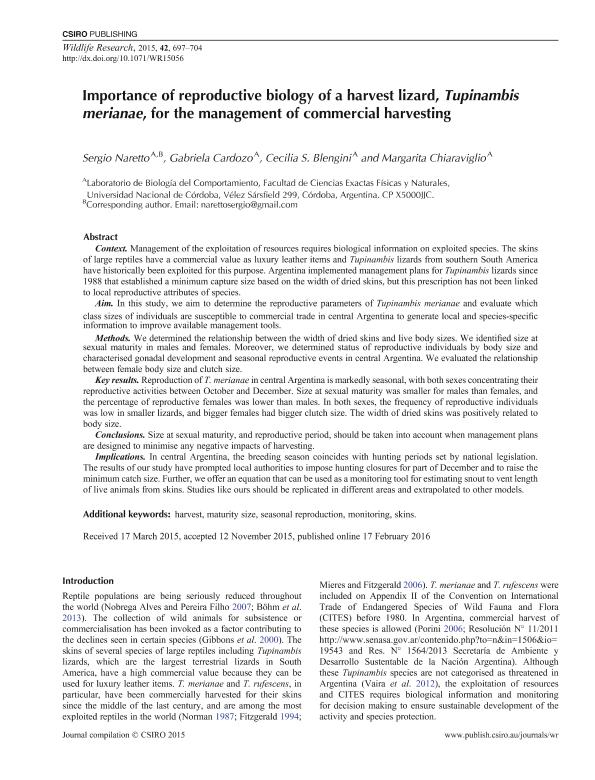Mostrar el registro sencillo del ítem
dc.contributor.author
Naretto, Sergio

dc.contributor.author
Cardozo Milanesio, Gabriela Alejandra

dc.contributor.author
Blengini, Cecilia Soledad

dc.contributor.author
Chiaraviglio, Margarita

dc.date.available
2018-08-24T17:17:45Z
dc.date.issued
2016-01
dc.identifier.citation
Naretto, Sergio; Cardozo Milanesio, Gabriela Alejandra; Blengini, Cecilia Soledad; Chiaraviglio, Margarita; Importance of reproductive biology of a harvest lizard, Tupinambis merianae, for the management of commercial harvesting; Csiro Publishing; Wildlife Research; 42; 8; 1-2016; 697-704
dc.identifier.issn
1035-3712
dc.identifier.uri
http://hdl.handle.net/11336/57010
dc.description.abstract
Context Management of the exploitation of resources requires biological information on exploited species. The skins of large reptiles have a commercial value as luxury leather items and Tupinambis lizards from southern South America have historically been exploited for this purpose. Argentina implemented management plans for Tupinambis lizards since 1988 that established a minimum capture size based on the width of dried skins, but this prescription has not been linked to local reproductive attributes of species. Aim In this study, we aim to determine the reproductive parameters of Tupinambis merianae and evaluate which class sizes of individuals are susceptible to commercial trade in central Argentina to generate local and species-specific information to improve available management tools. Methods We determined the relationship between the width of dried skins and live body sizes. We identified size at sexual maturity in males and females. Moreover, we determined status of reproductive individuals by body size and characterised gonadal development and seasonal reproductive events in central Argentina. We evaluated the relationship between female body size and clutch size. Key results Reproduction of T. merianae in central Argentina is markedly seasonal, with both sexes concentrating their reproductive activities between October and December. Size at sexual maturity was smaller for males than females, and the percentage of reproductive females was lower than males. In both sexes, the frequency of reproductive individuals was low in smaller lizards, and bigger females had bigger clutch size. The width of dried skins was positively related to body size. Conclusions Size at sexual maturity, and reproductive period, should be taken into account when management plans are designed to minimise any negative impacts of harvesting. Implications In central Argentina, the breeding season coincides with hunting periods set by national legislation. The results of our study have prompted local authorities to impose hunting closures for part of December and to raise the minimum catch size. Further, we offer an equation that can be used as a monitoring tool for estimating snout to vent length of live animals from skins. Studies like ours should be replicated in different areas and extrapolated to other models.
dc.format
application/pdf
dc.language.iso
eng
dc.publisher
Csiro Publishing

dc.rights
info:eu-repo/semantics/openAccess
dc.rights.uri
https://creativecommons.org/licenses/by-nc-sa/2.5/ar/
dc.subject
Harvest
dc.subject
Maturity Size
dc.subject
Monitoring
dc.subject
Seasonal Reproduction
dc.subject
Skins
dc.subject.classification
Otras Ciencias Biológicas

dc.subject.classification
Ciencias Biológicas

dc.subject.classification
CIENCIAS NATURALES Y EXACTAS

dc.title
Importance of reproductive biology of a harvest lizard, Tupinambis merianae, for the management of commercial harvesting
dc.type
info:eu-repo/semantics/article
dc.type
info:ar-repo/semantics/artículo
dc.type
info:eu-repo/semantics/publishedVersion
dc.date.updated
2018-08-17T14:30:20Z
dc.identifier.eissn
1448-5494
dc.journal.volume
42
dc.journal.number
8
dc.journal.pagination
697-704
dc.journal.pais
Australia

dc.journal.ciudad
Collingwood
dc.description.fil
Fil: Naretto, Sergio. Consejo Nacional de Investigaciones Científicas y Técnicas. Centro Científico Tecnológico Conicet - Córdoba. Instituto de Diversidad y Ecología Animal. Universidad Nacional de Córdoba. Facultad de Ciencias Exactas Físicas y Naturales. Instituto de Diversidad y Ecología Animal; Argentina
dc.description.fil
Fil: Cardozo Milanesio, Gabriela Alejandra. Consejo Nacional de Investigaciones Científicas y Técnicas. Centro Científico Tecnológico Conicet - Córdoba. Instituto de Diversidad y Ecología Animal. Universidad Nacional de Córdoba. Facultad de Ciencias Exactas Físicas y Naturales. Instituto de Diversidad y Ecología Animal; Argentina
dc.description.fil
Fil: Blengini, Cecilia Soledad. Consejo Nacional de Investigaciones Científicas y Técnicas. Centro Científico Tecnológico Conicet - Córdoba. Instituto de Diversidad y Ecología Animal. Universidad Nacional de Córdoba. Facultad de Ciencias Exactas Físicas y Naturales. Instituto de Diversidad y Ecología Animal; Argentina
dc.description.fil
Fil: Chiaraviglio, Margarita. Consejo Nacional de Investigaciones Científicas y Técnicas. Centro Científico Tecnológico Conicet - Córdoba. Instituto de Diversidad y Ecología Animal. Universidad Nacional de Córdoba. Facultad de Ciencias Exactas Físicas y Naturales. Instituto de Diversidad y Ecología Animal; Argentina
dc.journal.title
Wildlife Research

dc.relation.alternativeid
info:eu-repo/semantics/altIdentifier/url/http://www.bioone.org/doi/abs/10.1071/WR15056
dc.relation.alternativeid
info:eu-repo/semantics/altIdentifier/doi/http://dx.doi.org/10.1071/WR15056
Archivos asociados
